Unwanted, unwelcome, unsafe: Black students and confronting campus racism
By Richard B. Muhammad and J.A. Salaam -Final Call Staffers- | Last updated: Nov 18, 2015 - 9:40:02 PMWhat's your opinion on this article?
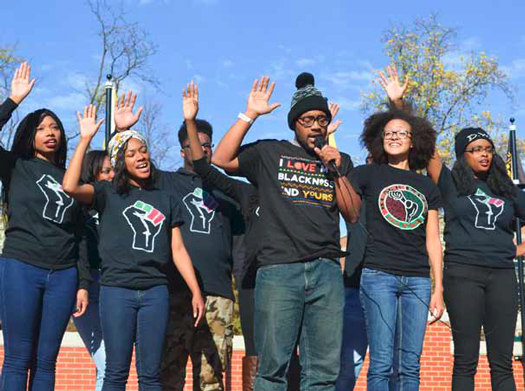
Students at University of Missouri protesting and demonstrating against racism, unfair treatment and difficulties they have experienced on campus. Photo: Elizabeth Loutfi / The Maneater
|
COLUMBIA, Mo. - Kimberlyn Jones graduated from the University of Missouri. With her daughter now attending, she shares a kind of legacy with the school.
It’s doubtful she expected her daughter to experience some of the same difficulties in 2015 that she experienced in the 1980s.
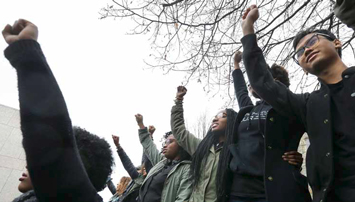
Students at Boston College raise their arms during a solidarity demonstration on the school’s campus, Nov. 12, in Newton, Mass. The protest was among numerous campus actions around the country following the racially charged strife at the University of Missouri. Photo: AP Wide World Photos
|
“I was a student at the University of Missouri from 1982-1987 and I experienced some things and had difficulty trying to find tutoring, financial aid and certain classes. I ended up graduating with a business major in 1988,” said Ms. Jones.
She was a member of the Legion of Black Collegians, a Black student group that has led demonstrations and pushed against White supremacy at the flagship state school. She was a Golden Girl and became captain as the only Black on the cheerleading squad.
“I do understand their frustrations and if I was there I would have stood with them in support. What they did brought a major change,” she said.
She recalls Mike Middleton, the new interim university president and a Black civil rights lawyer, teaching classes so popular at Mizzou she couldn’t get in. He was the third Black graduate of the university law school and will be the second Black president in the University of Missouri system.
“I think this is a new day, my parents were of the civil rights movement and to them this is another group trying to get something done to make a difference. It’s the same thing they had to deal with back then. My daughter is a Golden Girl too. She’s one of two Blacks on the squad and after 32 years now they have a second one,” Ms. Jones said during a break at the Missouri-BYU football game at Arrowhead Stadium in Kansas City, Mo.
The Tigers won the game, a game that was crucial to efforts by Black students to bring attention to campus racism and the university president’s failure to admit problems existed—let alone deal with them. Students said their efforts spanned years and little changed.
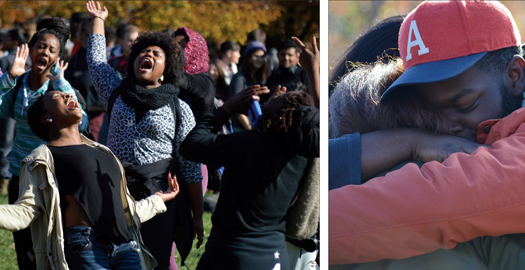
Concerned Student 1950 group members and supporters celebrate at the Mel Carnahan Quad after Tim Wolfe announced his resignation as University of Missouri president at a UM Board of Curators meeting on Nov. 9. Photos: Alexandria Churchill and Elizabeth Loutfi / The Maneater
|
In the end, Tim Wolfe was forced to resign as university president and R. Bowen Loftin stepped down as chancellor. Thirty football players had joined protests, backing a hunger strike by graduate student Jonathan Butler, who had vowed not to eat until Mr. Wolfe departed. Later the entire team, with the backing of outgoing coach Gary Pinkel, supported the players, saying they would not play or practice. Mizzou was facing a $1 million penalty if the Saturday evening game against BYU wasn’t played. Soon the top officials were out and an interim president had been appointed. Mizzou won the game 20-16, but the struggle is far, far from over.
For students at Missouri, the personnel change is a beginning but their demands and their concerns remain unmet. In addition, it is not only feeling unwanted or unwelcome that is the problem. Now there is acute awareness they are unsafe. The racial blowback from the Wolfe resignation was swift, and not limited to Mizzou. Threats to kill Black students at Mizzou showed up on Yik Yak, a social media app, and threats were leveled at students halfway across the country at Howard University, a historic Black school in Washington, D.C. Then a swastika appeared on the campus of Bowie State University, a historically Black institution in Maryland.
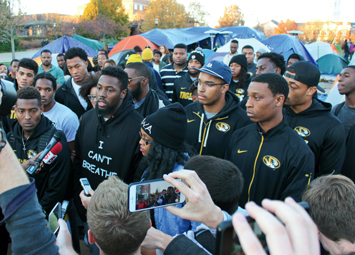
Missouri Tigers football players gathered to release a statement on Tim Wolfe’s resignation as UM System president and the conclusion of their boycott at Mel Carnahan Quad. Photo: Thomas Oide / The Maneater
|
Hunter Park, a 19-year-old student from Rolla, Mo., and Conner Stottlemyre, 19, were arrested and charged with making threats.
Tension was high on the main Columbia campus, where Nov. 13 there was an increased police and state trooper presence.
“These threats were fear tactics put out there to make (students) afraid to go to class. Especially when some of the people here don’t have scholarships; they’re paying for the class. Yet they are afraid to go to class and that’s not right. Because that’s not only hurting them, it’s hurting future generations and we can’t let that win. We have to make a stand,” said Jason McCallop. He came to Mizzou for a Friday protest in support of the Black students. Solidarity protests were held on campuses around the country as Mizzou students conducted a “We Are Not Afraid” march at the school.
“At some point there’s gonna be martyrs and I’ve never been afraid if that’s gonna’ be my place then that’s my place. But the point being it is that everybody should take a part. ’Cause we tried to get more people to come with us and unfortunately it was just us,” he said Nov. 13 while walking the campus.
The fight at the university has been and is an ongoing battle, said Mr. Butler. Students are still working on strategies and plan to meet with the football players, he added in a Nov. 12 interview.
“We want to see how the strategy we are planning fits into the bigger picture. So it’s important to know that there are other valuable voices of leaders who are standing up at this time as well and I don’t want to be the sole spokesperson for the movement on campus,” Mr. Butler said.
“My very first encounter with racism on this campus was actually going to one of the frat houses on the other side of campus and being kicked out and called ‘nigger bitches,’ I had support back then so it wasn’t that bad knowing I had it,” said Ayanna Poole, a co-founder of Concerned Student 1950, which has led many of the protests. The group’s name is taken from the date of the first Black student’s entry at the University of Missouri.
“But it could have taken such a bigger toll on me and I would have went back to Texas just because seeing that racial culture was here and it’s been ongoing. Then to see people in administration speak over us about coming up with these ‘ideas’ of how to make this campus better, but these are ideas that LBC (Legion of Black Collegians) released in 1969. These are ideas that the multi-cultural center has been fighting for over and over again. … Black and marginalized communities are suffering very harshly,” she said.
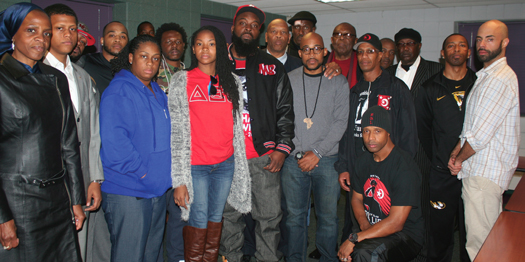
Mike Brown Sr. with activists Anthony Shahid and A. Akbar Muhammad of the Nation of Islam, with St. Louis and Kansas City delegation meets with Concerned Student 1950 and Jonathan Butler. Photo: J.A. Salaam
|
Blacks are about 8 percent of the student body at Missouri, whose undergraduate population is 79 percent White. In early October, members of a Black student organization said slurs were hurled at them by an apparently drunken White student. A swastika was smeared on a wall in feces and comments from the student government president, a Black male, about being called a nigger went viral this fall. At the homecoming parade Black students blocked Mr. Wolfe’s car, and he would not get out and talk to them. Police removed the protestors. Students demanded Mr. Wolfe resign and “acknowledge his White male privilege.” Concerned Student 1950 also wants a 10-year plan to retain non-White and other marginalized students and more diverse hiring at the university counseling center.
Activism among young people has seen a spectacular increase since the killing of Mike Brown, an 18-year-old unarmed Black male in Ferguson by a White police officer, which sparked a rebellion and heavily armed police, National Guardsmen, nonlethal weapons and tear gas in 2014. Mr. Butler joined those protests.
Mike Brown, Sr. and his wife Cam, along with activist Anthony Shahid and Abdul Akbar Muhammad of the Nation of Islam, were asked by students to come to the campus. They did. Closed door meetings with the students were held.
The delegation from St. Louis came to offer support and to listen to how they could help. Students, one by one, shared some of their ugly experiences, concerns and ideas.
Minister Akbar Muhammad listened as students talked about changing systemic racism they have had to endure.
“This doesn’t happen in a bubble, but this moment God has given to you and you have now begun to rock America and all in the academia is watching what has happened and they are preparing for it,” he said.
The struggle at Mizzou spawned a nationally trending hastag on Twitter, #blackoncampus, where students across the country shared their struggles. There was the ongoing campaign of Black students at Yale to oust the university president alongside resignations or protests at the University of Chicago, Claremont McKenna College in Claremont, Calif., Ithaca College in New York, Johns Hopkins University in Baltimore, Vanderbilt University in Nashville, Tenn., Smith College in Northampton, Mass., and the University of Iowa in Iowa City and the University of Michigan in Flint. Among other places where supportive actions were taken were Columbia University in New York, Syracuse University, Swarthmore College, San Diego State, the University of Southern California, the University of Kansas, Stanford University, Texas Southern University and Georgetown University.
Students at Occidental College in California announced Nov. 16 plans to occupy the college’s administration building for a week. Student leaders said that action follows a four-hour walkout and a Nov. 12 teach-in of over 600 students that ended with an occupation of the college president’s house. “The protest is organized by Oxy United for Black Liberation, a coalition of the Black Student Alliance (BSA) and THE Coalition at Oxy for Diversity and Equity (CODE). In addition to demanding the resignation of the college president Jonathan Veitch and 13 other institutional changes, these actions are in solidarity with University of Missouri and the hundreds of other educational institutions across the country protesting campus racial injustice,” said student leaders in a statement.
“Although there was public support for the walk-out and teach-in from other students and members of the faculty, the backlash from this effort included at least one student organizer receiving a death threat. This is one small example of the various forms of violence—physical, emotional, and discursive—that Black students and other students of color face every day at the hands of this institution,” they added.
“The movement happening across the nation at different campuses alerts me that our struggle (as Black students at PWI’s—Predominantly White Institutions) is not isolated to Oxy. The fact that we are not alone is disturbing because it assures me that the marginalization of students of color, especially Black students, is a systemic issue,” said sophomore Zawadia LeFang.
The 14 demands include the removal of President Jonathan Veitch, “creation of a Black Studies major; the hiring of more faculty of color; an increase in funding for campus organizations run by students of color; and the creation of a diversity training for faculty and students.”
“These demands have been reiterated before and students feel that current efforts by the college are not enough,” said protest organizers.
According to the National Center for Education Statistics, enrollment in degree-granting institutions hit 17.7 million in 2012. Between 1976 and 2012, the percentages of Latino, Asian/Pacific Islander and American Indian/Alaska Native students increased. The percentage of Black students rose from 10 percent to 15 percent, the center reported. “During the same period, the percentage of White students fell from 84 percent to 60 percent,” the center added.
Black and non-White students are still under-represented on college campuses.
“Unity is needed when making a bridge between different cultures and even schools. As a student at the University of Missouri Kansas City, I traveled to Mizzou to show support for people of color and to stand up for the injustices in the public school system,” said 19-year-old Nakia Brandon.
“Change is needed in this society and it is needed in the classrooms for people of color, for racial segregation, and for the injustices in society. We are tired. Black people are tired. Colored people are tired. It needs to end or like we said in our chant ‘we want a revolution,’ ” she said.
INSIDE STORIES AND REVIEWS
-
-
About Harriett ... and the Negro Hollywood Road Show
By Rabiah Muhammad, Guest Columnist » Full Story -
Skepticism greets Jay-Z, NFL talk of inspiring change
By Bryan 18X Crawford and Richard B. Muhammad The Final Call Newspaper @TheFinalCall » Full Story -
The painful problem of Black girls and suicide
By Charlene Muhammad -National Correspondent- » Full Story -
Exploitation of Innocence - Report: Perceptions, policies hurting Black girls
By Charlene Muhammad -National Correspondent- » Full Story -
Big Ballin: Big ideas fuel a father’s Big Baller Brand and brash business sense
By Bryan Crawford -Contributing Writer- » Full Story






 Click Here Stay Connected!
Click Here Stay Connected!








